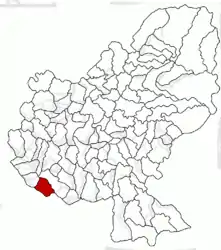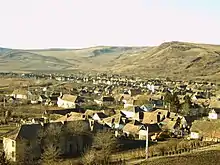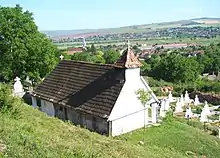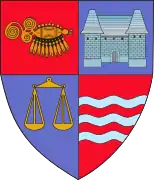Adămuș
Adămuș (Hungarian: Ádámos; Hungarian pronunciation: [ˈaːdaːmoʃ]) is a commune in Mureș County, Transylvania, Romania. It is composed of six villages: Adămuș, Chinciuș (Kincses), Cornești (Sövényfalva), Crăiești (Magyarkirályfalva), Dâmbău (Küküllődombó; German: Hügeldorf) and Herepea (Magyarherepe).
Adămuș
Ádámos | |
|---|---|
.JPG.webp) Adămuș town hall | |
 Coat of arms | |
 Location in Mureș County | |
 Adămuș Location in Romania | |
| Coordinates: 46°18′N 24°14′E | |
| Country | Romania |
| County | Mureș |
| Government | |
| • Mayor (2020–2024) | Tibor-Laszlo Miklos[1] (UDMR) |
| Area | 82.35 km2 (31.80 sq mi) |
| Elevation | 290 m (950 ft) |
| Population (2011-10-31)[2] | 5,147 |
| • Density | 63/km2 (160/sq mi) |
| Time zone | EET/EEST (UTC+2/+3) |
| Vehicle reg. | MS |
| Website | primariaadamus |
Geography
The commune is situated on the Transylvanian Plateau, on the left bank of the river Târnava Mică. It is located in the southwestern part of the county, on the border with Alba County and near the border with Sibiu County. Adămuș is at a distance of 6.5 km (4 mi) from Târnăveni, 28 km (17 mi) from Mediaș, and 43 km (27 mi) from the county seat, Târgu Mureș.
History
Until 1918, the village belonged to the Kis-Küküllő County of the Kingdom of Hungary. After the Hungarian–Romanian War of 1918–19 and the Treaty of Trianon of 1920, it became part of Romania.
Demographics
According to the 2011 census, Adămuș has a population of 5,147, of which 43.46% are Romanians, 38.47% are Hungarians, and 14.96% are Roma.
Natives
- László Hunyadi (born 1933), sculptor
- Jenő Korodi (born 1922), painter
- Lajos Ütő (1885–1977), pastor
See also
- List of Hungarian exonyms (Mureș County)
- Unitarian church from Adămuș
- Wooden church from Chinciuș
- Wooden church from Dâmbău
References
- "Results of the 2020 local elections". Central Electoral Bureau. Retrieved 11 June 2021.
- "Populaţia stabilă pe judeţe, municipii, oraşe şi localităti componenete la RPL_2011" (XLS). National Institute of Statistics.


